ISSN ONLINE(2319-8753)PRINT(2347-6710)
ISSN ONLINE(2319-8753)PRINT(2347-6710)
| Niyaz A. Mir, A. Khan, A. A. Dar and M. Muneer* Department of Chemistry, Aligarh Muslim University, Aligarh – 202002, India |
| Corresponding author: M. Muneer |
| Related article at Pubmed, Scholar Google |
Visit for more related articles at International Journal of Innovative Research in Science, Engineering and Technology
This paper deals with the photocatalyzed decolorization kinetics of two azo dye derivatives, Ponceau BS and Reactive Blue 160 under a variety of conditions in aqueous suspension of TiO2 using UV light. The efficiency of different TiO2 photocatalysts such as PC500-Milennium, UV100-Hombikat and P25-Degussa were compared for the decolorization of both dyes. Photocatalytic, photolytic, and adsorption experiments were performed, showing that adsorption of both dyes on TiO2-UV100 is appreciable compared to that on P25 and favorable by the Langmuir approach. The effects of various parameters such as catalyst loading, initial pH, substrate concentration and electron acceptors such as H2O2, KBrO3 on the decolorization have been investigated. Under the operating conditions of this study, the photocatalytic decolorization of dyes under study followed pseudo first-order kinetics. The photo decolorization kinetics was discussed in terms of Langmuir-Hinshelwood kinetic model. The decolorization efficiency was found to be efficient in acidic medium which gradually slowed down in the alkaline medium due to the effect of charge repulsion.
Keywords |
| Adsorption; Decolorization; Photocatalysis; Ponceau BS; Reactive Blue 160; TiO2 |
INTRODUCTION |
| Water is one of the nature’s most important gifts to mankind and its quality is crucial for the future of humanity. Rapid industrialization, though one of the surest ways of achieving accelerated economic growth, has affected human health directly or indirectly by releasing wastes and untreated wastewater into the environment. Among the various chemicals responsible for polluting water resources, dyes have been reported to have a major contribution [1]. Everyday dye factories across the world are dumping million of tons of dye effluents into the water bodies thereby polluting both fresh water of rivers as well as underground water which indirectly affects the human health as well as agricultural crops that also has an indirect impact on human health. Approximately more than 10,000 different dyes and pigments are utilized by textile industry with the annual worldwide production almost 2,000,000 tons. Azo dyes, predominate textile industry, containing one or more azo bonds (N=N) and different chromophores allow for personalized color requirement. More than 2000 structurally different azo dyes are in commercial usage [2]. Due to the poor exhaustion properties of azo dyes, almost 40% of the initial dyes doesn’t fix to the fabrics and finally end up in the dye effluents. Even though dye concentration in these wastewater effluents amount to only a small proportion of total water pollution but their strong brilliance affects aesthetic value, water transparency and gas solubility of water bodies obstructing photosynthetic activity of aquatic plants and seriously affecting the whole ecosystem [3]. The stability of azo dyes under acidic/alkaline conditions and resistance to breakdown is responsible for their persistence and high accumulation levels in the environment [4, 5]. Their presence in water is of great concern since their precursors or biotransformation products like aromatic amines have been assessed for potential mutagenicity and genotoxicity [6, 7]. Therefore in recent years treatment of dye effluents has acquired growing interest and the techniques for decolorization of dyes and removal of colored organic chemicals are under development [8, 9]. Various traditional techniques used for the treatment of dye effluents include physical or chemical methods such as flocculation, electro flocculation, membrane filtration, ion exchange, electro kinetic coagulation, precipitation etc but each method has technical and economic limitations [10]. Recently heterogeneous photocatalysis using TiO2 has proven to be a promising alternative technology to conventional methods for the removal of toxic organic dyes from industrial effluents, since it not only degrades the pollutants but also causes their complete mineralization to CO2, H2O and mineral acids [11-14]. In case of photocatalytic decolorization of dyes, there is a possibility of direct absorption of light by the dye which can lead to charge injection from exited state of the dye to the conduction band of the semiconductor as summarized in the following Eqs. (1-2); |
 |
| Both Ponceau BS (PBS) and Reactive Blue 160 (RB160) are diazo commercial dyes containing sulphonate groups. PBS is used to dye wool, silk, cotton, paper whereas RB160 is used for dyeing cotton, viscose, flex and jute but not suitable for silk, wool and polyester. PBS has also been used as a plasma stain instead of acid fuchsin in Masson’s trichome. Few studies related to the decolorization of Ponceau BS in the presence of nano photocatalysts are reported in literature [15, 16]. RB160 contains triazine rings and these types of dyes are of particular importance due to well known resistance of the s-triazines to light induced fading. However, only a few studies on their decolorization have been reported in the literature [17-20]. Therefore we have studied the detailed decolorization kinetics of these two dyes keeping in view their wide spread use and thereby possibility of their release in wastewater. The chemical structure of PBS and RB160 is shown in chart 1. |
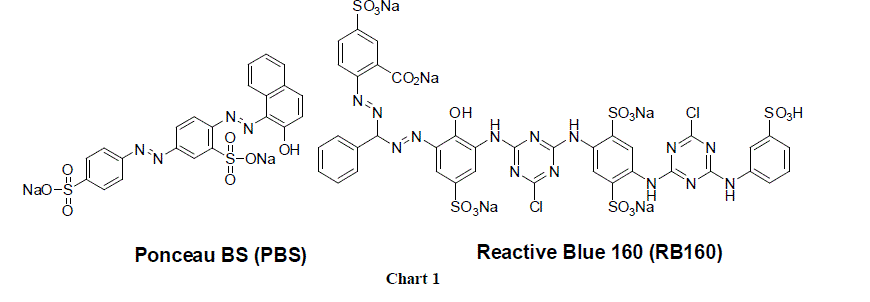 |
II. EXPERIMENTAL METHODS |
| A. Reagent and Chemicals |
| The dye derivative PBS was purchased from Sigma-Aldrich India whereas RB160 was supplied by Atul India Ltd. Valsad, Gujarat India and were used as such without any further purification. Most of the heterogeneous photocatalytic tests were carried out using Degussa P-25 TiO2 (Degussa AG, anatase: rutile: 80:20, specific BET 50 m2g−1, particle size 21 nm) [21] Other TiO2 catalyst powders used for comparison were Hombikat UV100 (Sachtleben Chemie GmbH, anatase, specific BET 250 m2g-1, particle size 5-10 nm) [22] and PC500 (Millennium Inorganic Chemicals, anatase, specific BET 320 m2g-1 , particle size 5-10 nm) [23]. All other chemicals used in this study such as sodium hydroxide, nitric acid, hydrogen peroxide and potassium bromate were of reagent grade obtained from Merck. Double distilled water was used throughout the work. Aqueous stock solutions of the dyes were prepared, protected from light and stored at 25 oC. |
| B. Experimental setup and procedures |
| Photocatalytic experiments were carried out in an immersion well photoreactor made of Pyrex glass equipped with a magnetic bar, a water circulating jacket and an opening for molecular oxygen. Required amount of the photocatalyst was then added and equilibration of the solution was assured by continuous stirring and atmospheric oxygen supply for at least 15 minutes in the dark. Irradiations were carried out using 125 W medium pressure mercury lamp (Philips). The light intensity was measured by UV-light intensity detector (Lutron UV-340) and was found to be in the range of 1.49- 1.51 mW/cm2. During the photocatalytic experiments, 180 mL of the aqueous dye solution of desired concentration containing the appropriate quantity of the catalyst was stirred magnetically, while the solution was purged continuously with atmospheric oxygen. At specific time intervals, samples (6 mL) were withdrawn, centrifuged in order to remove TiO2 particles and subsequently analyzed. Heterogeneous photocatalytic experiments with TiO2 were carried out at pH 4.9 and 6.3 for PBS and RB160 respectively, unless otherwise stated in the text. The reaction temperature was kept constant at 20±0.3 oC. |
| C. Analysis |
| The decolorization of dyes was monitored using UV spectroscopic analysis technique (Shimadzu UV-vis 1601). The double beam spectrophotometer has an in-built tungsten and deuterium lamps, which provide the measurement of optical density (OD) in the range 200-1100 nm (near-UV and visible regions). The samples were analyzed using quartz cuvette, as it has zero absorption in the above wavelength regions. The concentrations of dye derivatives were calculated by standard calibration curve obtained from the absorbance of the dye at different concentrations. The change in absorbance of the dyes PBS and RB160 was followed at their ïÃÂìmax 505 and 618 nm, respectively, as a function of irradiation time. The observed absorbance is proportional to Beer-Lambert Law in the range of studied dye concentration. The effect of each parameter was studied by fixing the values of other parameters. The pH of the solution was measured by using Hanna Instruments (HI 2210) digital pH meter. |
III. RESULTS AND DISCUSSION |
| A. Dark adsorption |
| Adsorption of pollutants on the semiconductor surface is an important parameter in heterogeneous photocatalysis since it determines the photocatalytic degradation/decolorization rate. The adsorption experiments were carried out in order to evaluate the equilibrium constants of adsorption. Adsorption isotherm expresses the relationship between the mass of dye adsorbed per unit weight of the TiO2 and equilibrium concentration of the dye in solution. Stock solutions of the different initial dye concentrations, Cin were prepared. Ten milliliters from each solution were transferred into 10 mL colored standard flasks each preloaded with TiO2 (Degussa P25 and Hombikat UV100) at a concentration of 1gL-1. The flasks were then agitated simultaneously for 24 h at room temperature in an incubator orbital shaker. The suspensions were centrifuged in order to remove the TiO2 particles and the equilibrium concentration of dyes, Ceq was determined. The amount of the substrate adsorbed onto the catalyst, q (mol g-1) was determined using Eq. (3). |
 |
| Where q is the amount of dye adsorbed per unit weight of the TiO2 at equilibrium and CTiO2 (g L-1) is the concentration of the TiO2. |
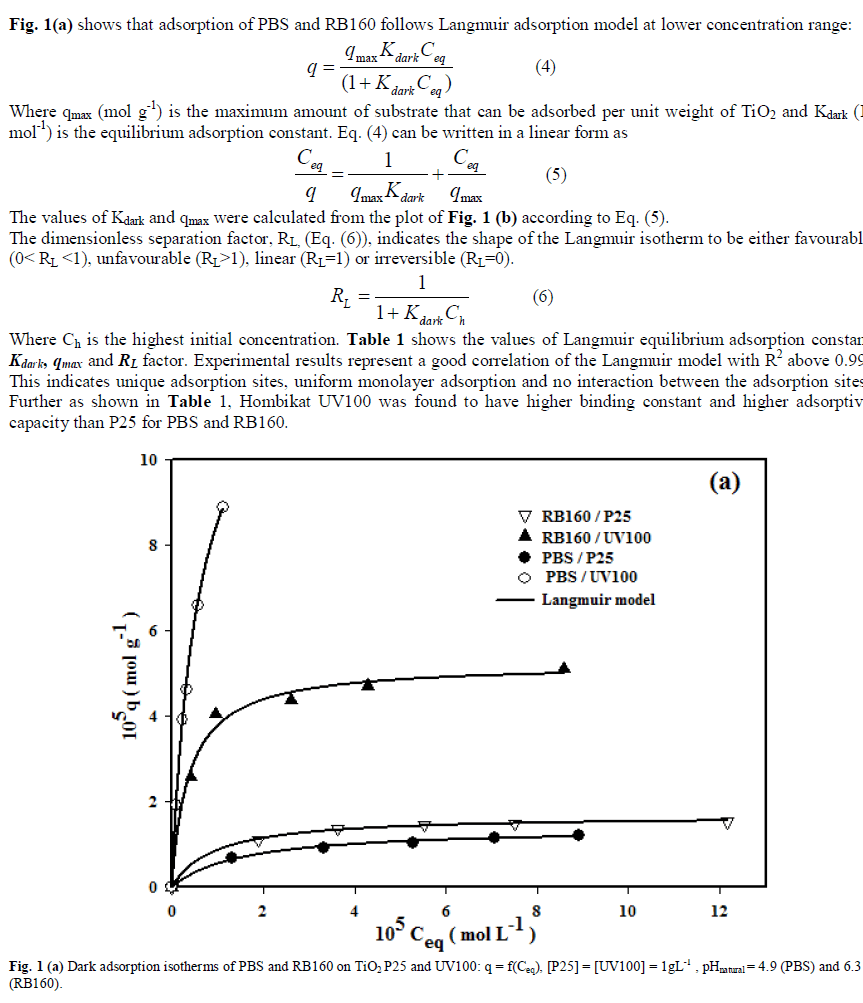 |
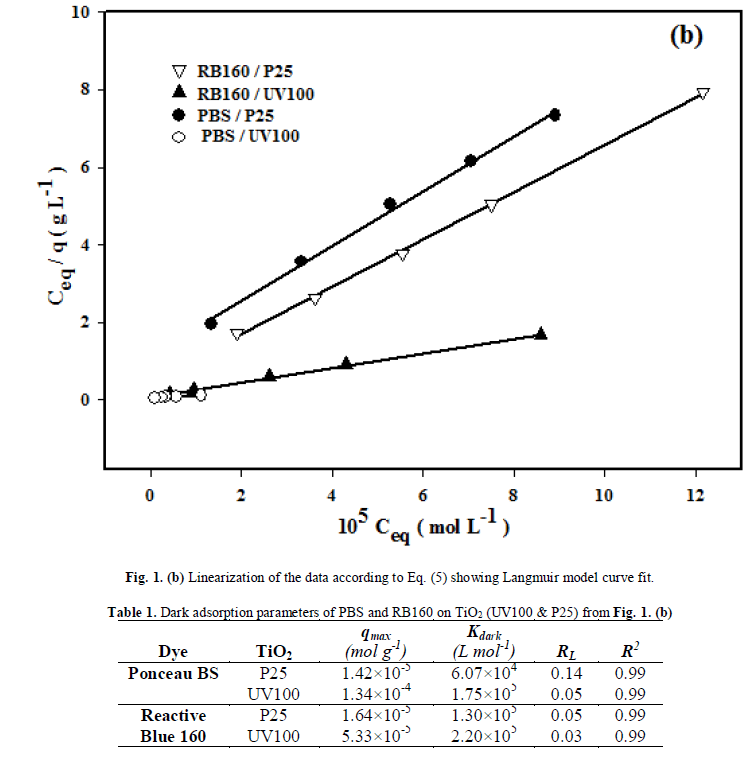 |
| B. Photolysis and Photocatalysis |
| Irradiation of an aqueous solutions of PBS (0.1 mM, 180 ml, pH 4.9) and RB160 (0.137 mM, 180 ml, pH 3.4) in the presence of TiO2 (Degussa P25, 1 gL-1) using 125 W medium pressure mercury lamp lead to decrease in absorption intensity, at their ïÃÂìmax 505 and 618 nm respectively, as a function of irradiation time as shown in Fig. 2 (a-b). In order to evaluate the efficiency of various processes on dye decolorization, experiments were carried out under the following conditions: (1) dye+ hv, (2) dye+PC500+ hv (3) dye+P25+ hv,(4) dye+UV100+hv, (5) dye+KBrO3+hv, (7) dye+P25+KBrO3+hv, (9) dye+H2O2+hv and (10) dye+P25+H2O2+ hv. The results are depicted in Fig 3 (a-b). The efficiency of various processes was assessed in terms of percent decolorization and values of rate constant (Kapp). The percentage of decolorization (R) was estimated by the following equation (7): |
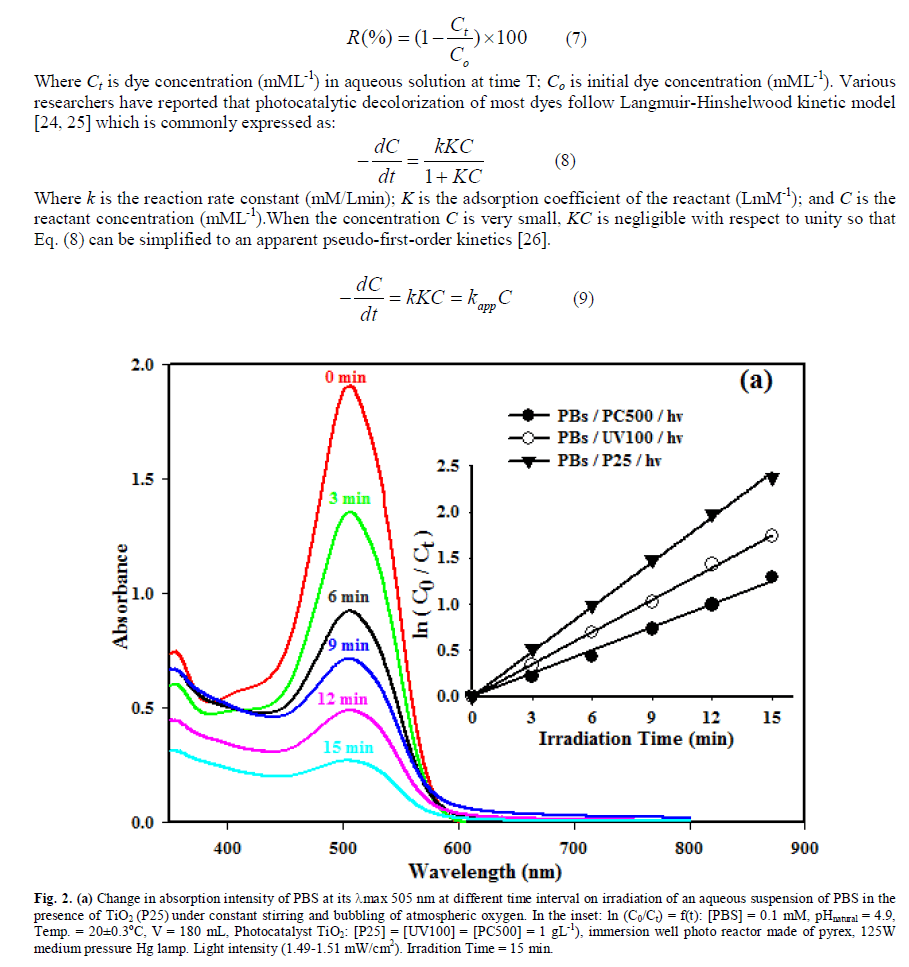 |
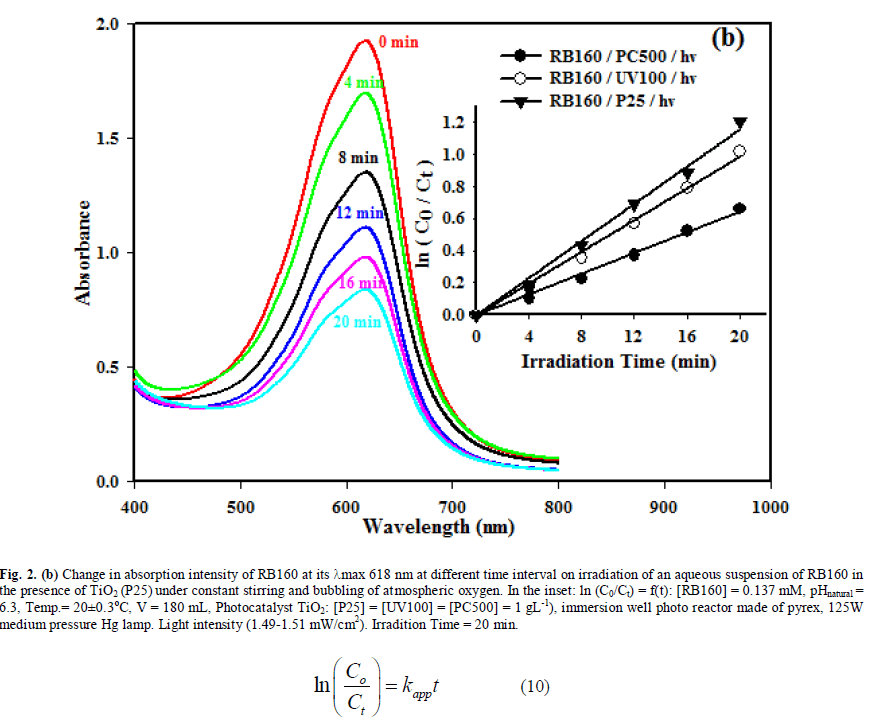 |
| Where kapp is the apparent pseudo-first-order rate constant (min-1). As shown in Fig. 3 (a-b) the direct photolysis (UV alone) wasn’t found to be an efficient process for the decolorization of PBS and RB160 and can be neglected since less than 7% of conversion occurred within 15 and 20 min of UV light illumination respectively. The combined action of UV light and different types of TiO2 powders showed efficient decolorization. The application of PC500 resulted in 72.68% and 48.39% decolorization of PBS and RB160 within 15 and 20 minutes of illumination respectively. The corresponding efficiencies with other catalysts were found to be; 82.41% and 63.78% for UV100 and 90.68% and 70.04% for P25. The decolorization efficiency of H2O2 with UV light alone was found to be 28.86% and 23.54% for PBS and RB160 and that with KBrO3 was 9.92% and 9.03% respectively. The addition of TiO2 (P25) along with H2O2 increased the efficiency upto 99.28% and 98.12% and that with KBrO3 99.93% and 99.25 % respectively. The above results demonstrated that the photocatalytic experiments occurred in a pure photocatalytic regime where photolytical processes can be neglected. For our experimental conditions, data are in good agreement with pseudo first-order reaction as depicted by plotting ln (C0/Ct) versus irradiation time as shown in the inset of Fig. 2 (a-b).The correlation constant for the fitted lines was calculated to be R2= 0.99 for all three catalyst. The rate constants (Kapp) were calculated to be 0.0831 min-1, 0.1163 |
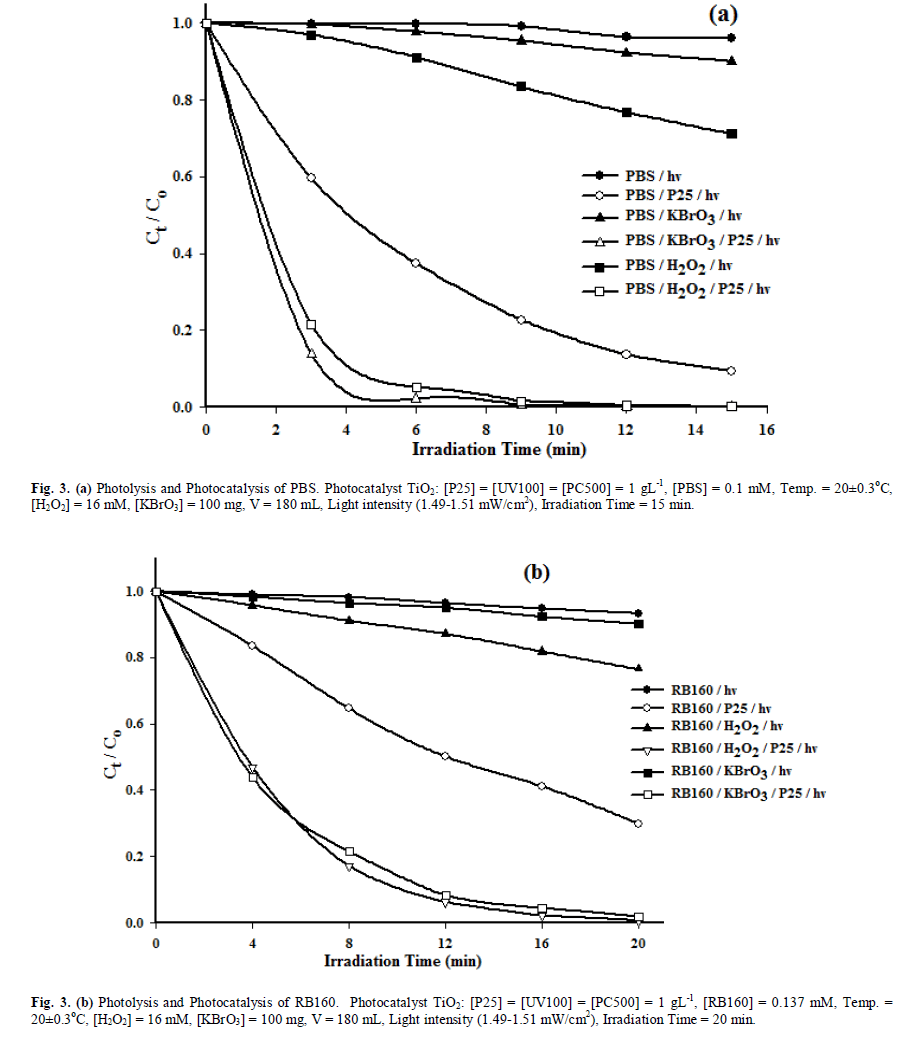 |
| min-1 and 0.1620 min-1 for PC500, UV100 and P25 respectively in case of PBS. The corresponding rate constants for RB160 were 0.0321 min-1, 0.0493 min-1 and 0.0577 min-1 respectively. C. Effect of catalyst dosage In case of heterogeneous systems reaction rates have been found to be dependent on catalyst loadings therefore for the economic removal of dye effluents from the waste water, it is necessary to find out the optimum amount of catalyst for efficient decolorization [27]. The effect of catalyst loading on the decolorization of PBS and RB160 was investigated using Degussa P25 and UV100 from 0.5 to 3 gL-1 keeping all other parameters constant. The apparent rate constants of different catalysts amounts shown in Table 2 can be obtained from the plot of ln (C0/Ct) versus irradiation time. The increase of catalyst amount from 0.5 to 1 gL-1 increased the decolorization efficiency from 68.08 to 82.41% using UV100 and 71.73 to 90.68% using P25 in case of PBS. Further increase in catalyst loading decreased the decolorization efficiency. In case of RB160 increase of catalyst amount from 0.5 to 3 gL-1 increased the decolorization efficiency from 26.61 to 89.94% using UV100 and 27.73 to 90.98% using P25. The decolorization of dyes is influenced by the number of available active sites, extent of photo-absorption of the catalyst used and the adsorption of dyes onto the catalyst surface [28]. The increase in decolorization efficiency with increase in catalyst dosage in case of PBS can be attributed to the fact that TiO2 addition increases the available active sites for dye adsorption on the photocatalyst. However, further increase in catalyst loading (>1gL-1) lead to decrease in decolorization efficiency. At higher catalyst loading, the agglomeration of the catalyst increases the turbidity of the suspension reducing the light penetration. This results in decreased catalytic surface and hence less active sites as well as decreased generation of active species responsible for photocatalytic reactions [29]. Needless to say that this optimum amount of catalyst depends on the initial concentration of the pollutant, geometry and the working conditions of the reactor and corresponds to the optimum of light absorption [30]. Therefore, a TiO2 (UV100) loading of 1 gL-1 was selected as the optimum value for the following photocatalytic experiments. |
 |
| D. Effect of initial dye concentration From mechanistic as well as from application point of view it is important study the dependence of decolorization kinetics on the initial dye concentration. The effect of various initial dye concentrations on the photocatalytic decolorization of PBS and RB160 has been investigated from 0.02 to 0.1 and 0.03-0.137 mML-1 respectively at their natural pH with catalyst loading of 1gL-1. As shown in Fig. 4, it was found that value of Kapp decreased with increase in initial dye concentration. The decolorization efficiencies were 90.68%, 93.84%, 95.83%, 97.27% and 98.24%, respectively, at the initial PBS concentration of 0.1, 0.08, 0.06, 0.04 and 0.02 mML-1 after 15 min of irradiation. The corresponding efficiencies for RB160 were 70.04%, 76.08%, 81.58%, 85.50% and 90.08%, respectively, at the initial concentration of 0.137, 0.09, 0.07, 0.05 and 0.03mML-1 after 20 min of irradiation. With increase in initial substrate concentration, the shielding of light takes place which may result in decreased light triggered catalyst. Moreover at higher initial dye concentration, the intermediates formed may compete, along with the substrate molecules, for the constant total sites available for adsorption at a fixed concentration of TiO2. This will obviously reduce the formation rate of hydroxyl and superoxide radicals necessary for redox reactions to occur. Many authors have used Langmuir-Hinshelwood (L-H) kinetic model to describe the heterogeneous photocatalytic reactions successfully in terms of the concentration of the target molecule [31]. The experimental data has been rationalized in terms of the modified form of L-H kinetic model to describe the solid-liquid reaction successfully. The rate of oxidation is proportional to the surface coverage of dye onto the TiO2 assuming the concentration of intermediates adsorbed onto the catalyst is negligible compared to that of the primary substrate. The effect of initial dye concentration on the decolorization efficiency can be depicted by rewriting Eq. 8 and 9 as: |
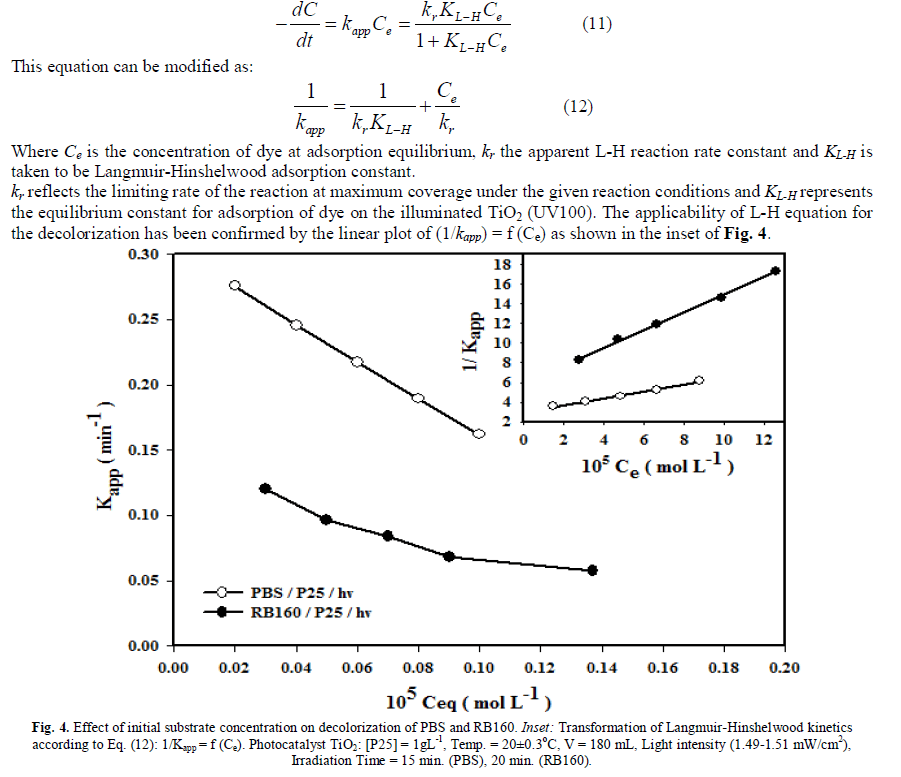 |
| The values of kr and KL-H are shown in Table 3. The values of calculated adsorption constant Kdark for PBS and RB160 (Table 1) were about 5.2 and 8.66 times higher, respectively, than the adsorption constant KL-H for photocatalytic experiments with P25. The result is in accordance with previously reported result where KL-H of three herbicides has been found to be almost similar or slightly lower than their respective Kdark values [31]. It has been reported by other authors that the binding constants of many organic substrates determined under photocatalytic conditions are always greater than the binding constants measured in dark adsorption experiments [32, 33]. The reasons for this are a matter of debate in the literature. However, this general trend could not be confirmed in the case of the photocatalytic decolorization of the dye studied in this work. In reality, the binding constants in Eq. (10) rarely correspond to the adsorption/desorption equilibrium constants determined in the dark due to possible modification of the surface characteristics and adsorption sites when the surface of TiO2 is irradiated with UV light [33, 34]. |
 |
| E. Effect of initial pH Since acid-base properties of metal oxide surfaces can have considerable implications upon their photocatalytic activity [35], therefore solution pH is an important parameter that influences the photocatalytic decolorization of colored effluents. The effect of initial pH on the decolorization of PBS and RB160 was investigated at different pH values ranging from 3 to 11 at initial dye concentration of 0.1 and 0.137 mML-1 respectively and TiO2 (P25) amount of 1gL-1. The results are illustrated in Fig. 5. Increase in pH of PBS solution from 3.5 to 4.9 lead to increase in decolorization efficiency. Further increase in pH from 5.2 to 10.5 had apparent decrease in PBS decolorization. After 15 minutes of irradiation, the calculated decolorization efficiency was 88.49% in strong acidic medium (pH 3.5), 90.68% at natural pH (pH 4.9) and 43.75% in the alkaline medium (pH 11.0). In case of RB160 the decolorization efficiency was found to decrease with increase in pH from 3.4 to 10.8. It was found to be 88.09% in acidic medium (pH 3.4), 70.04% at natural pH 6.3 and 17.93% in alkaline medium at pH 10.8. The results indicated that photocatalytic decolorization of both azo dyes PBS and RB160 was most efficient in acidic medium than in alkaline solution. Since the pHpzc of TiO2 is about 6.35 [36], the TiO2 surface will be positively charged (Eq. (13)) in acidic medium (pH<6.35) whereas it will be negatively charged (Eq. (14)) in alkaline medium (pH>6.35). |
| When pH<Pzc: TiOH + H+ ↔ TiOH2 + (13) When pH>Pzc: TiOH + OH- ↔ TiO- +H2O (14) |
| Both azo dyes PBS and RB160 will be negatively charged in solution due to hydrolysis of sulphonate groups. The efficient decolorization in acidic medium may be attributed to strong adsorption due to electrostatic attraction between negatively charged PBS and RB160 dye molecules and positively charged TiO2 surface. With increase in pH, the repulsive forces between negatively charged dye molecules and negatively charged catalyst surface (TiO-) minimizes the adsorption of the dye and hence the observed decolorization of PBS and RB160 slowed down. Moreover the reductive cleavage of azo bonds by electrons in the conduction band under acidic pH may also contribute to the better decolorization of azo dyes [37]. The slight decrease in decolorization efficiency at pH 3.4 in case of PBS may be due to fact that at low pH values TiO2 particles agglomerate decreasing the catalyst surface area available for adsorption of dye molecules as well as photon absorption [38]. There are several reports on better decolorization of anionic dyes (mainly sulphonated dyes) in acidic medium followed by a decrease in alkaline medium [39, 40]. |
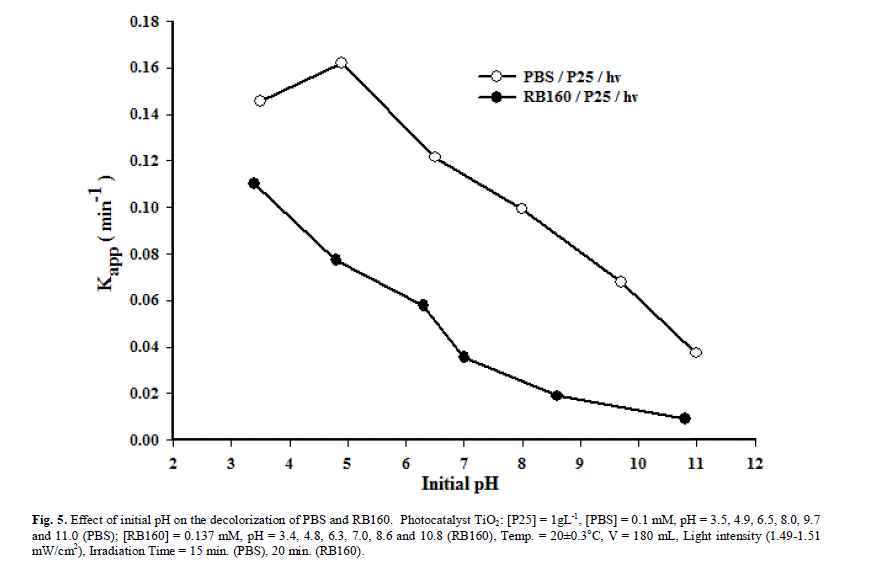 |
| F. Effect of Electron acceptors In highly coloured wastewater where the decolorization is a major concern, the addition of electron acceptors to enhance the decolorization rate may often be justified. The effect of electron acceptors such as hydrogen peroxide and potassium bromate in presence of TiO2 (Degussa p25) on the decolorization of PBS and RB160 has been investigated. 1) Effect of H2O2: The effect of addition of H2O2 on the decolorization of PBS and RB160 was investigated by varying it from 4 mM to 16 mM. As is evident from the Fig. 6, the low concentration of H2O2 had a negative effect on the decolorization of RB160 which is opposite of the trend for UV/H2O2/TiO2 process. However with increase in concentration of H2O2 the percentage of decolorization increases. It was observed that percentage of decolorization (70.04%) in the absence of H2O2 decreased to 62.15% due to the presence of 4 mML-1 of H2O2. The adsorption of H2O2 molecules on TiO2 particles in competition with RB160 dye molecules may lead to the scavenging of positive holes and thereby decreasing the hydroxyl radical formation according to Eq. (15) and (16). Moreover at lower concentrations, the hydrogen peroxide can also scavenge the hydroxyl radicals generated at the TiO2 surface before they enter the bulk of the solution which ultimately decreases the hydroxyl radical concentration and hence decolorization process. The results are in good agreement with previously reported results on degradation of dicamba and methyl tert-butyl ether [41, 42]. In case of PBS, H2O2 addition increased the decolorization rate at all dosages. The enhancement in decolorization efficiency with H2O2 addition may be attributed to hydroxyl radical’s formed due to self decomposition of H2O2 by UV light (Eq. 17) and the ability of H2O2 to trap conduction band electrons so as to prevent electron-hole recombination ( Eq. 18) [43]. |
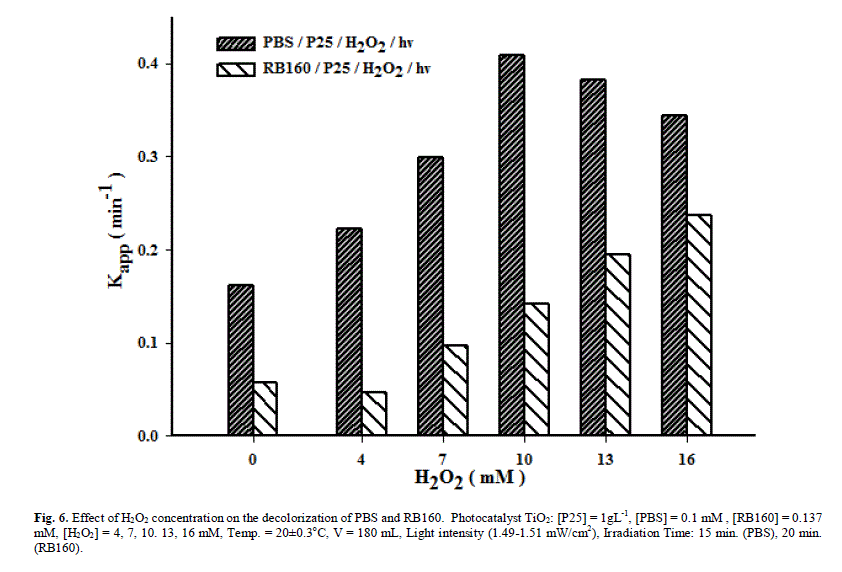 |
| 2) Effect of KBrO3: The effects of KBrO3 addition on the decolorization of PBS and RB160 was investigated by varying its concentration from 20 to 100 mg. As shown in Fig. 7, the addition of KBrO3 has enhancing effect at all dosages on the decolorization of PBS and RB160 when used along with TiO2. It was found that addition of 100 mg of KBrO3 to PBS and RB160 solutions along with TiO2 lead to 3.52 and 3.45 fold increases in the Kapp values, respectively, compared to that with TiO2 only. The corresponding percentages of decolorization were 99.86 and 98.12% compared to 90.68 and 70.04% using TiO2 alone at the rate of 1 gL-1 respectively. |
| The effective electron acceptor ability of KBrO3 has been observed in a number of previous studies [44]. The enhancement of the decolorization rate may be attributed to the reaction between bromate anion and conduction band electron (Eq. (19)) which reduces the electron–hole recombination [45]. A change in reaction mechanism due to reduction of bromate ions by electrons leading to the formation of other reactive radicals or oxidizing species like BrO2 and HOBr might be another possible reason for this rate enhancement. Furthermore, bromate ions by themselves can act as oxidizing agents as proposed by Linder for the photocatalytic degradation of 4-chlorophenol [46]. A similar mechanism might also be operative in dyes under investigation. |
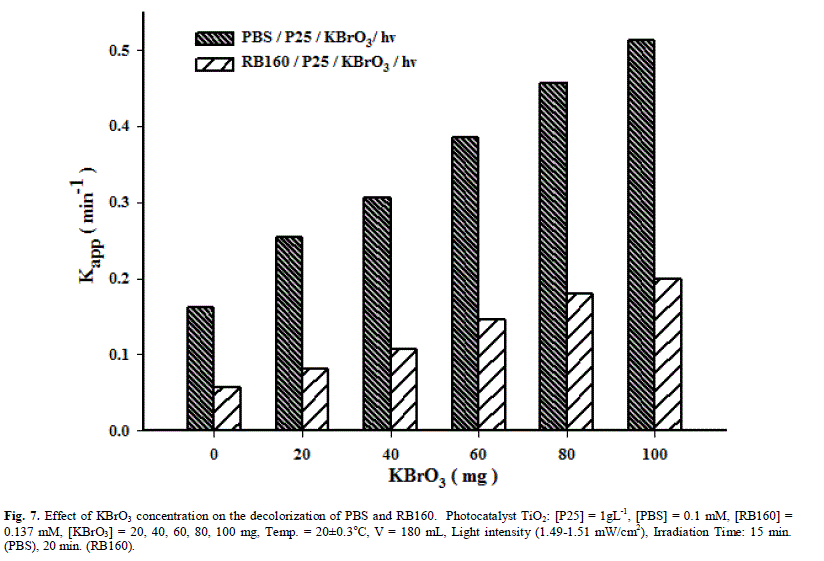 |
IV.CONCLUSIONS |
| Heterogeneous photocatalysis using TiO2 as photocatalyst was proven to be an effective method for the decolorization of PBS and RB160. The adsorption of PBS and RB160 on TiO2 was found favorable by the Langmuir approach. The values of adsorption constant on TiO2 for both dyes determined during photocatalytic experiment were found to be smaller than that measured in the dark which is a rarely reported situation in photocatalytic studies. This study also pointed out the dependence of the photocatalytic decolorization on operating conditions such as substrate concentration, solution pH and TiO2 dosage. The decolorization of RB160 was retarded at lower H2O2 dosage which is opposite of the trend for UV/H2O2/TiO2 process while KBrO3 enhanced the decolorization at all dosages. |
ACKNOWLEDGEMENTS |
| Financial support to Research Projects from UGC New Delhi, CSTUP Lucknow and DRS-1 (SAP) from UGC, New Delhi to the Department of Chemistry, Aligarh Muslim University, Aligarh and the award of Senior Research Fellowship to Niyaz A. Mir by the UGC, New Delhi is gratefully acknowledged. |
References |
|